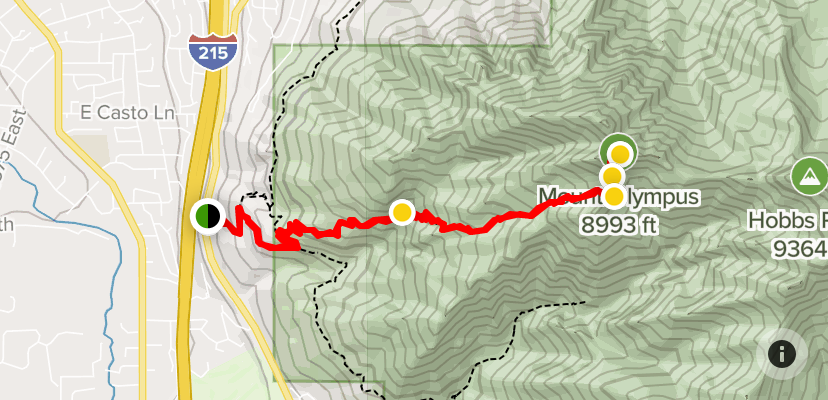Known for its skiing, the Sundance Film Festival, and being home to five national parks, Utah is a perfect destination for any outdoor enthusiast. If you’ve been craving a stimulating, yet relatively short hike that offers you tremendous physical and visual rewards but can’t decide where to go, then give Utah’s Mount Olympus a try.
Get to Know Mount Olympus
In 1984, Mount Olympus was designated a wilderness area. The Mount Olympus Wilderness Area covers more than 15,000 acres and ranges between 5,000 and 10,000 feet in elevation. Mount Olympus is 9,026 feet high and is found in the Salt Lake Valley region.
Before white settlers took over the area, the Salt Lake Valley was shared between the Goshute, Ute, and Shoshone tribes. Its history consists of flour, molasses, lumber, and shingle mills. However, it wasn’t until after World War II that the area began to be fully developed, including its first elementary school in the 1950s.
Route to the Top
The Mount Olympus Trailhead, which is the trail that leads you to the top, is located on Wasatch Boulevard on the east side of Salt Lake City. It’s easy to find as it starts from the parking lot.
The trail is roughly 8 miles out and back, and easy enough for anyone to follow. It is, however, fairly steep with over 4,000 feet of elevation gain in less than 4 miles. There are no flat sections of the trail and you are climbing the entire time. The path does offer momentary shade in some places.
Scrambling will be required towards the end of your hike, and the rocks can be slick and covered with loose pebbles. Proper shoes, gear, and attire are vital to reaching the summit of Mount Olympus.
Once you reach the top, there is a hiker mailbox where you can leave your legacy as part of Mount Olympus. Simply fill in your name and the date of your climb. Before descending back the way you came up, take in the breathtaking panoramic view.
To enjoy Mount Olympus without reaching the summit, Grandeur Peak, Neffs Canyon Trail, Desolation Trail, and Butler Fork Loop are wonderful alternatives. Each one offers a different perspective and rewards.
Other Activities
Besides summiting Mount Olympus, the wilderness area offers many other outdoor adventures, including trail running, camping, fishing, and rock climbing. Trail running is permitted almost anywhere hikers are found unless otherwise noted. Cross country skiing and snowboarding areas can be accessed on foot via snowshoeing or skinning.
Rules and Regulations
There are no fees to hike Mount Olympus, but there are activities that are prohibited in some parts of the wilderness. This includes mountain biking or snowmobiling—no mechanical vehicle of any kind is allowed. Neither humans nor dogs may swim in sections of water that fall into the watershed.
To avoid altering the landscape, it is illegal to cut through forested areas that are not marked by a trail or are hiker-made trails. To properly dispose of human waste, pack it out in Waste Alleviation and Gelling (WAG) bags or by digging a hole between six and eight inches deep at a minimum of 200 feet from a trail or water source.
Camping is allowed in the wilderness area, but campers are asked to use existing sites so that vegetation is not destroyed by newly made sites. Camping stoves and campfires are permitted in most areas. When building a campfire, one must use existing fire rings and must completely put out the fire, and scatter the non-smoldering ashes in wooded areas. Campsites should be left without human traces.
Fishing requires a license and the use of clean waders. Keep in mind that waders should be washed before entering new bodies of water. This is to avoid cross-contamination between water sources, including fish.
When rock climbing, bolts must be changed using hand drills and not power drills. Gear must be placed on durable surfaces and chalk and tick marks must be cleaned up. Everything you bring in must be packed out.
Gear, Safety, and Planning
What you wear and bring all depends on the activity you’ll be partaking in. Some of the important items include a first aid kit, proper shoes, socks, hat, sunglasses, sunblock, water, food, rope, crampons, harness, gloves, helmet, and weather-appropriate clothing to name a few.
The best time to hike Mount Olympus for beginners is summer and early autumn. For experts and skilled climbers, Mount Olympus can be hiked year-round as long as you are well prepared.
As with most outdoor adventures, check with the rangers at the wilderness areas before heading out. Many activities require specific conditions to be met. Practice courtesy and always be aware of your surroundings. Mount Olympus is waiting to show you Utah from a new and beautiful perspective.

